中班语言《啊~蜘蛛》说课稿
- 二、说教材《啊~蜘蛛》这本书蕴含着人与蜘蛛两个不同的阅读角度,从人类的角度阅读是一种情绪体验,而通过观察,关键情景变化的图片,转换为以蜘蛛为主角进行阅读就会产生另外一番感受。这个故事讲述的是一只小蜘蛛,却想成为一家人的宠物,它与这家人之间发生了很多有趣的事情。蜘蛛喜与悲的细节表情,人物夸张的动作,画面的色彩都蕴含着不同的情感信息,我通过动与静结合的阅读方法,引导幼儿在阅读画面的同时调动内部信息去观察、理解故事内容,以增强幼儿对故事的阅读理解能力。三、说活动目标1、能够关注画面中人物的细节表情与动作,从中体会角色情绪,尝试用不同的语气进行表现。2、能够从小蜘蛛的角度阅读故事,理解故事中小蜘蛛的情感和行为。四、说重点难点重点:从人与蜘蛛的不同角度进行阅读,体验角色情感的变化。难点:能够理解小蜘蛛的感受,从小蜘蛛的角度进行表达。
-
收藏模板
- 模板信息
- 更新时间:2022-10-22
- 字数:约2225字
- 页数:约5页
- 格式:.docx
- 推荐版本:Office2016及以上版本
- 售价:5 金币
您可能喜欢的文档
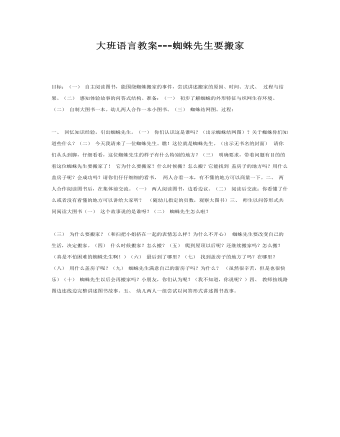
大班语言教案---蜘蛛先生要搬家
一、回忆知识经验,引出蜘蛛先生。(一)你们认识这是谁吗?(出示蜘蛛结网图)?关于蜘蛛你们知道些什么?(二)今天我请来了一位蜘蛛先生。瞧!这位就是蜘蛛先生。(出示无书名的封面) 请你们从头到脚,仔细看看,这位蜘蛛先生的样子有什么特别的地方?(三)明确要求,带着问题有目的的看这位蜘蛛先生要搬家了!它为什么要搬家?什么时候搬?怎么搬?它能找到盖房子的地方吗?用什么盖房子呢?会成功吗?请你们仔仔细细的看书, 两人合看一本,有不懂的地方可以商量一下。二、两人合作阅读图书后,在集体前交流。(一)两人阅读图书,边看边议。(二)阅读后交流:你看懂了什么或者没有看懂的地方可以讲给大家听? (随幼儿指定的页数,观察大图书)三、师生以问答形式共同阅读大图书(一)这个故事说的是谁呀?(二)蜘蛛先生怎么啦?(
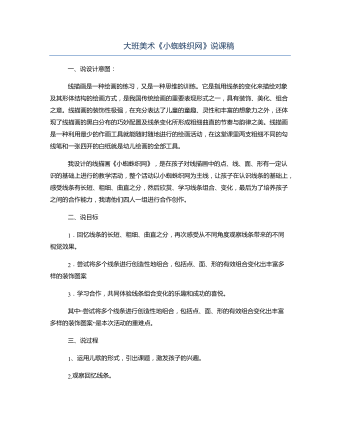
大班美术《小蜘蛛织网》说课稿
线描画是一种绘画的练习,又是一种思维的训练。它是指用线条的变化来描绘对象及其形体结构的绘画方式,是我国传统绘画的重要表现形式之一,具有装饰、美化、组合之意。线描画的装饰性极强,在充分表达了儿童的童趣、灵性和丰富的想象力之外,还体现了线描画的黑白分布的巧妙配置及线条变化所形成粗细曲直的节奏与韵律之美。线描画是一种利用最少的作画工具就能随时随地进行的绘画活动,在这堂课里两支粗细不同的勾线笔和一张四开的白纸就是幼儿绘画的全部工具。我设计的线描画《小蜘蛛织网》,是在孩子对线描画中的点、线、面、形有一定认识的基础上进行的教学活动,整个活动以小蜘蛛织网为主线,让孩子在认识线条的基础上,感受线条有长短、粗细、曲直之分,然后欣赏、学习线条组合、变化,最后为了培养孩子之间的合作能力,我请他们四人一组进行合作创作。
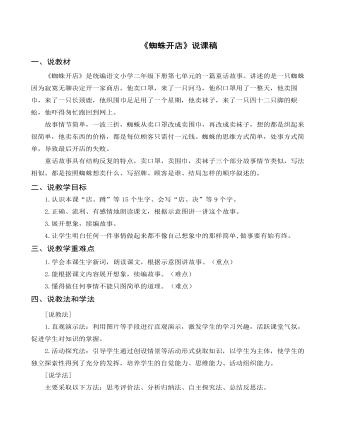
(说课稿)《 蜘蛛开店》部编人教版二年级上册语文
(二)初读故事,学习生字新词。1.打开课本大声朗读课文,遇到不认识的字,我们该怎么办?(借助拼音、查字典、寻求他人帮助等)【设计意图】帮学生提供学习方法,鼓励学生自主识字 2.老师在读课文时,也遇到了“拦路虎”,谁来帮帮我?(出示带拼音的生字)3.去掉拼音,你还能认识他们吗?谁来当小老师领着大家认一认?4.自己试着读一读,你是用什么办法可以把它们记得更牢固? 5.同学们的识字方法真多,相信你们一定把这些字都认识了,我们来开火车读一读吧?6.生字宝宝很调皮分别找了个好朋友让我们认一认,女生先来认一认?男生再来认一认。 7.词语宝宝真有趣,跑到句中,谁能读?出示带有生字的句子,指导朗读。①有一只蜘蛛,每天蹲在网上等着小飞虫落在上面,好寂寞,好无聊啊。②卖什么呢?就卖口罩吧,因为口罩织起来很简单。③口罩好难织啊,蜘蛛用了一整天的工夫,终于织完了。 ④第二天,蜘蛛的招牌又换了,上面写着:“袜子编织店,每位顾客只需付一元钱。” ⑤可是,蜘蛛看到顾客后,却吓得匆忙跑回网上。原来那位顾客竟是一条四十二只脚的蜈蚣。【设计意图】本环节出示的句子都是有代表性的句子,除了句子中都含有本课的生字外,又能让学生在读句子中初步感悟课文内容。
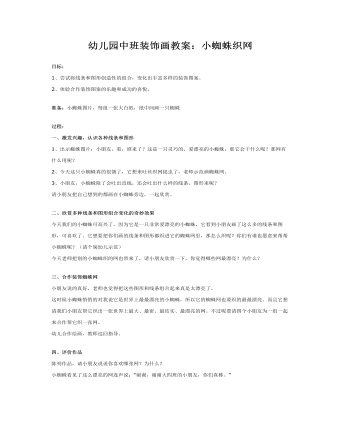
幼儿园中班装饰画教案:小蜘蛛织网
2、体验合作装饰图案的乐趣和成功的喜悦。 准备:小蜘蛛图片,每组一张大白纸,纸中间画一只蜘蛛 过程: 一、激发兴趣,认识各种线条和图形 1、出示蜘蛛图片:小朋友,看,谁来了?这是一只灵巧的、爱漂亮的小蜘蛛,那它会干什么呢?那网有什么用呢? 2、今天这只小蜘蛛真的很饿了,它想来吐丝织网捉虫了,老师示范画蜘蛛网。 3、小朋友,小蜘蛛除了会吐出直线,还会吐出什么样的线条、图形来呢? 请小朋友把自己想到的都画在小蜘蛛旁边,一起欣赏。 二、欣赏多种线条和图形组合变化的奇妙效果 今天我们的小蜘蛛可高兴了。因为它是一只非常爱漂亮的小蜘蛛,它看到小朋友画了这么多的线条和图形,可喜欢了。它想要把你们画的线条和图形都织进它的蜘蛛网里,那怎么织呢?你们有谁也愿意来帮帮小蜘蛛呢?(请个别幼儿示范) 今天老师把别的小蜘蛛织的网也带来了,请小朋友欣赏一下,你觉得哪些网最漂亮?为什么?

大班科学教案:结网的蜘蛛
活动目标: 1、认识蜘蛛,知道蜘蛛是节肢动物,有吐丝结网的特性。 2、能用科学的态度对待蜘蛛,对蜘蛛不再有害怕和厌恶的情绪。 3、在游戏中培养幼儿丰富的想象力和创造力。 活动准备: 1、课件:各种蜘蛛的幻灯片、蜘蛛结网的动画。 2、彩条、橡皮筋、毛线、幼儿电脑、水彩笔、白纸。 3、在活动室贴上幼儿活动前自己收集的各种蜘蛛的图片。 活动过程: 1、师带幼儿进入活动室,请幼儿观察:今天活动室有什么特别的地方?(让幼儿自由观察贴在墙上的各种蜘蛛的图片)。 2、师告诉幼儿:这些图片都是小朋友们和爸爸、妈妈一起收集的,真能干!今天老师也收集了许多各种各样的蜘蛛图片,请小朋友们来看看。然后展示各种蜘蛛的幻灯片让幼儿观看。 3、师请幼儿讨论: (1)你看到蜘蛛心里有什么感觉? (2)蜘蛛是我们的朋友吗?你喜欢它吗? 4、将幼儿分成两派:喜欢蜘蛛的坐到一边,讨厌蜘蛛的坐到一边。 5、请幼儿分组商量:为什么喜欢(讨厌)蜘蛛?并给自己的小组取名字。
- 查看更多相关Word文档
转载请注明出处!本文地址:
https://www.lfppt.com/worddetails_95042548.html最新说课稿文档
-
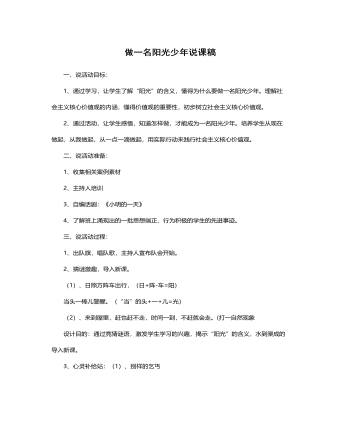
做一名阳光少年说课稿
1、紧密联系学生的生活实际,所选材料、所有活动均本着为主题服务的原则。2、形式多样化。通过心灵补给站、我来当编剧、心动不如行动等丰富多彩的活动,激发学生的热情,充分发挥他们的主体性。3、用生活中的真人真事激励他们,震撼他们的心灵,对学生进行教育,让他们得到感悟。五、说评价方式:要真正发挥主题队会的教育作用,千万不能把主题队会开成“检讨会”、“批评会”。兴趣是最好的老师,在课堂上,学生有了兴趣,才会有学习的动机,所以,在教学过程中,我努力把学生当作一个平等的朋友来对待,对于学生的回答进行评价时,本着“多表扬少批评,多鼓励少指责”的原则,尽量不用指令性、批评性的语言,最大限度的挖掘学生的优点,进行激烈性评价。

追思先烈魂,弘扬爱国情说课稿
环节四深入实践——弘扬爱国情爱国不是一句口号,要将爱国情怀落实到行动中去,队员们在各队队长的组织下,商讨出了落实方案。1、第一小队和第二小队组成了先烈故事演讲团,利用班会十分钟的时间,在三四年级宣讲先烈故事。2、第三小队和第四小队组成了创编小能手,编唱了爱国童谣、爱国拍手歌,告诉大家,爱国无处不在,爱国要从小事做起。3、第五小队和第六小队编写的爱国倡议书,提倡大家让爱国从口号落实到行动。4、全体队员共同宣誓:时刻准备着,为共产主义事业而奋斗,将活动推向了高潮。环节五大队辅导员总结“风雨沧桑,多遭铁蹄践踏,未有沉沦终奋起;荡涤污浊,重聚华夏精魂,披荆斩棘勇向前。”让我们牢记自己是中国人,怀一颗中国心,明确方向,努力奋斗,早日实现自己的梦想。
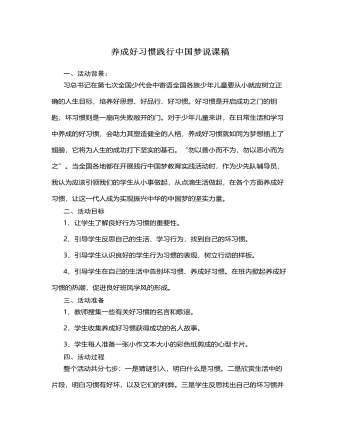
养成好习惯践行中国梦说课稿
第七步:全班学生一起倡读承诺书:(课件出示)我们都是小学生,培养习惯最要紧;上课应当专心听,积极开动小脑筋;作业认真仔细做,按时完成交得勤;有了错误要订正,知识才能学得清;人生要有好习惯,我们牢牢记心上。最后请学生把自己要养成的好习惯写在心意卡上,写好后粘贴在教室后面的园地里,互相督促,使得此次活动教育延续课后,直至影响一生.5、活动效果及反思此次活动开展后,学生们增强了对自身的认识,很多学生下决心改掉自身的坏习惯,并逐步采取了实际行动,从身边的小事做起,而且在学生中间还兴起了互相帮助、互相指正、争相进步的热潮。通过此次活动我也切实的体会到养成教育要开展就要落到实处,从实际出发,让学生亲自去感受,去体会,并且要持之以恒的做下去。同时作为老师更应该有一颗敏感热情的心,随时发现学生身上的闪光点与不足,多指正、多指点、多鼓励、多表扬,做到时时处处皆教育,这样才能赢得孩子,做好教育。
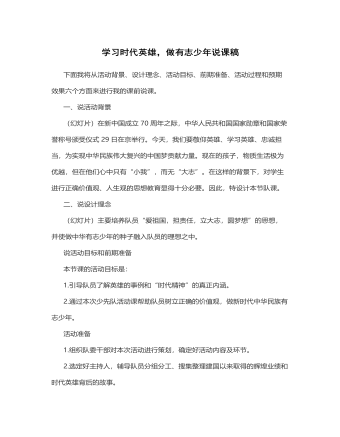
学习时代英雄,做有志少年说课稿
一、说活动背景(幻灯片)在新中国成立70周年之际,中华人民共和国国家勋章和国家荣誉称号颁受仪式29日在京举行。今天,我们要敬仰英雄、学习英雄、忠诚担当,为实现中华民族伟大复兴的中国梦贡献力量。现在的孩子,物质生活极为优越,但在他们心中只有“小我”,而无“大志”。在这样的背景下,对学生进行正确价值观、人生观的思想教育显得十分必要。因此,特设计本节队课。二、说设计理念(幻灯片)主要培养队员“爱祖国,担责任,立大志,圆梦想”的思想,并使做中华有志少年的种子融入队员的理想之中。说活动目标和前期准备本节课的活动目标是:1.引导队员了解英雄的事例和“时代精神”的真正内涵。2.通过本次少先队活动课帮助队员树立正确的价值观,做新时代中华民族有志少年。
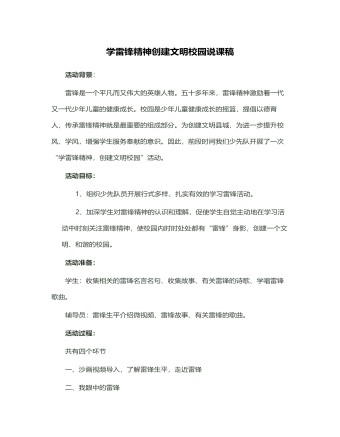
学雷锋精神,创建文明校园说课稿
雷锋精神是什么?这一环节是让学生用简单的词语或句子概括。通过这一活动,让学生概括出雷锋精神的内涵:像无私奉献、乐于助人、为人民服务、勤俭节约、尊老爱幼、勤奋好学、干一行爱一行、言行一致等等都是雷锋精神的体现。我们少年儿童是中国的未来和希望,雷锋精神的发扬和光大,创建文明校园的任务就落在他们的肩上,所以在这里我还设计了为发扬雷锋精神,创建文明校园“我该怎么做”这样的问题,目的就是让他们一起行动起来,学雷锋做好事,并制作了“荣誉”旗,奖励身边的好人好事。活动延伸:这里我设计了一个角色游戏活动——我要义卖献爱心,这个游戏学生们表现得非常积极,他们收集了自己不要的小文具或小玩具,将他们拿到集市上去卖,卖东西获得的钱,捐给王奶奶的孙女,因为王奶奶的孙女生病了,无钱治病。我觉得这个游戏使学生们懂得,一个人只要有爱心,只要愿意去帮助别人,无论什么方式都行,而且在游戏活动中孩子们体会到了帮助别人是一件多么多么快乐的事呀。
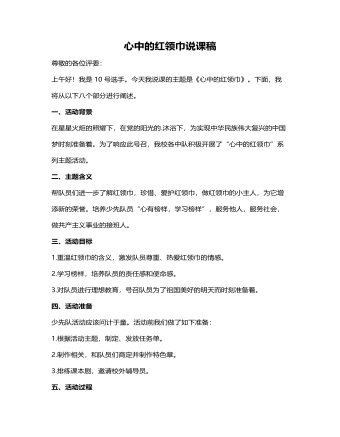
心中的红领巾说课稿
1.学习“最美红领巾”。图文结合,学习“美德少年”刘华婷、刘颖等人的先进事迹。2.记录“平凡红领巾”。展示队员们活动前精心准备的“随手拍”,发现普通队员在日常生活中的闪光点。3.填写“我为红领巾添光彩”心愿卡,对学生进行理想教育。4.齐唱《红领巾之歌》,点燃信念火种。5.辅导员对此次活动进行总结,并颁发特色章。(出示三个特色章图标)六、活动延伸红领巾精神需要代代相传,珍爱红领巾的意识需要时时提醒,本次活动后,我们会开展“小小新四军”、“鲜艳的红领巾”等后续活动,帮助队员们将红领巾精神永远铭记在心。七、引导要点四年级队员具备一定的活动能力和经验,通过课本剧的亲身体验、心愿卡的真情表达等多种方式的运用,引导队员热爱红领巾,以红领巾精神指引自己健康成长。八、活动评价本次活动,队员们受到了良好的教育。但是四年级队员自我约束能力不够强,缺乏持久性,萌生的意识和激情往往只停留在活动时,不能在活动后内化为自觉行为,这些问题有待探究。
今日更新Word
-
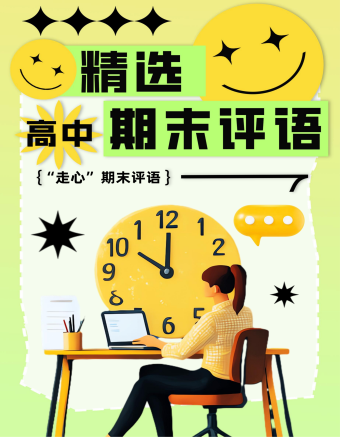
精选高中生期末评语
1、该生学习态度端正 ,能够积极配合老师 ,善于调动课堂气氛。 能够积极完成老师布置的任务。学习劲头足,听课又专注 ,做事更认 真 ,你是同学们学习的榜样。但是,成绩只代表昨天,并不能说明你 明天就一定也很优秀。所以,每个人都应该把成绩当作自己腾飞的起 点。2、 你不爱说话 ,但勤奋好学,诚实可爱;你做事踏实、认真、为 人忠厚 ,是一个品行端正、有上进心、有良好的道德修养的好学生。在学习上,积极、主动,能按时完成老师布置的作业,经过努力 ,各 科成绩都有明显进步,你有较强的思维能力和学习领悟力,学习也有 计划性,但在老师看来,你的潜力还没有完全发挥出来,学习上还要有持久的恒心和顽强的毅力。
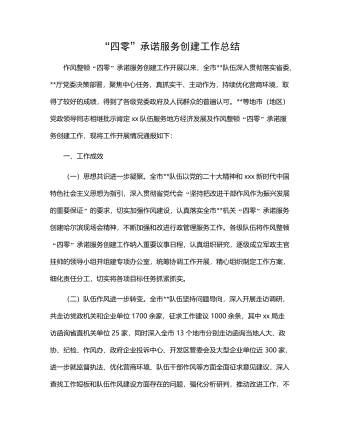
“四零”承诺服务创建工作总结
(二)坚持问题导向,持续改进工作。要继续在提高工作效率和服务质量上下功夫,积极学习借鉴其他部门及xx关于“四零”承诺服务创建工作的先进经验,同时主动查找并着力解决困扰企业和群众办事创业的难点问题。要进一步探索创新,继续优化工作流程,精简审批程序,缩短办事路径,压缩办理时限,深化政务公开,努力为企业当好“保姆”,为群众提供便利,不断适应新时代人民群众对政务服务的新需求。(三)深化内外宣传,树立良好形象。要深入挖掘并及时总结作风整顿“四零”承诺服务创建工作中形成的典型经验做法,进一步强化内部宣传与工作交流,推动全市创建工作质效整体提升。要面向社会和公众庄严承诺并积极践诺,主动接受监督,同时要依托电台、电视台、报纸及微信、微博等各类媒体大力宣传xx队伍作风整顿“四零”承诺服务创建工作成果,不断扩大社会知情面和群众知晓率。
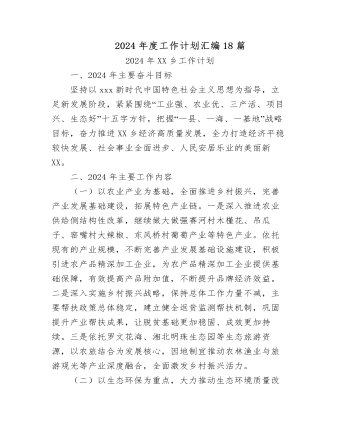
2024年度工作计划汇编(18篇)
1.市政基础设施项目5项,总建设里程2.13km,投资概算2.28亿元。其中,烔炀大道(涉铁)工程施工单位已进场,项目部基本建成,正在办理临时用地、用电及用水等相关工作;中铁佰和佰乐(巢湖)二期10KV外线工程已签订施工合同;黄麓镇健康路、纬四路新建工程均已完成清单初稿编制,亟需黄麓镇完成图审工作和健康路新建工程的前期证件办理;公安学院配套道路项目在黄麓镇完成围墙建设后即可进场施工。2.公益性建设项目6项,总建筑面积15.62万㎡,投资概算10.41亿元。其中,居巢区职业教育中心新建工程、巢湖市世纪新都小学扩建工程已完成施工、监理招标挂网,2月上旬完成全部招标工作;合肥职业技术学院大维修三期已完成招标工作,近期签订施工合同后组织进场施工;半汤疗养院净化和医用气体工程已完成招标工作;半汤疗养院智能化工程因投诉暂时中止;巢湖市中医院(中西医结合医院)新建工程正在按照既定计划推进,预计4月中下旬挂网招标。
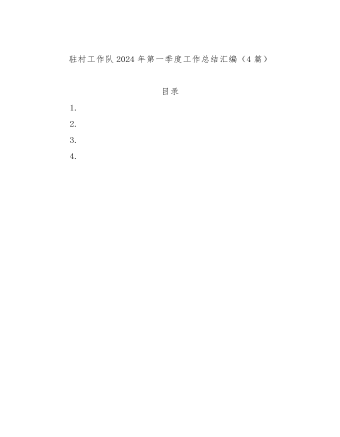
驻村工作队2024年第一季度工作总结汇编(4篇)
三是做大做强海产品自主品牌。工作队于xx年指导成立的冬松村海产品合作社,通过与消费帮扶平台合作,在工作队各派出单位、社会团体、个人支持下,已获得逾xx万元销售额。2022年底工作队推动合作社海产品加工点扩建的工作方案已获批,待资金下拨后将正式启动扩建工作。四是积极助企纾困,带动群众增收致富。工作队利用去年建立的xx镇产业发展工作群,收集本地企业在产品销售、技术、人力、资金、运营、用地等方面的需求,并加大xx支持乡村振兴力度,xx助理赴各村委开展多场xx政策支持乡村振兴宣讲活动,本季度有x万元助农贷款获批,xx万贷款正在审批中。在壮大既有产业的同时,完善联农带农机制,一方面鼓励企业雇用本地农户就业,另一方面计划与本地农户签订长期收购合同,让农民种得放心、种得安心,带动当地群众共同致富。

主题教育总结常用提纲大全
第一,主题教育是一次思想作风的深刻洗礼,初心传统进一步得到回归。第二,主题教育是一次沉疴积弊的集中清扫,突出问题进一步得到整治。第三,主题教育是一次强化为民服务的生动实践,赤子之情进一步得到提振。第四,主题教育是一次激发创业担当的有利契机,发展层次进一步得到提升。2.第一,必须提领思想、武装思想。第二,必须聚焦问题、由表及里。第三,必须领导带头、以上率下。第四,必须务实求实、认真较真。3.一是抬高政治站位,坚持大事大抓。二是坚持思想领先,狠抓学习教育。三是突出问题导向,深入整改纠治。四是坚持领导带头,发挥表率作用。4.一是立足“早”字抓筹划。二是着眼“活”字抓学习。三是围绕“统”字抓协调。5.一是形势所需。二是任务所系。三是职责所在。四是制度所定。6.一要提升认识。二要积极作为。三要密切协作。
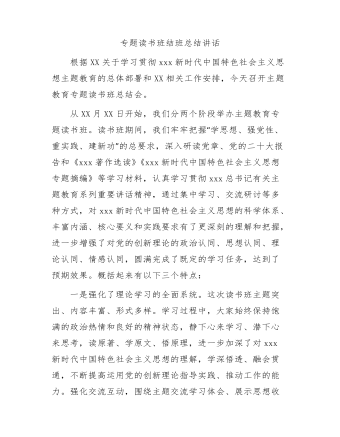
主题教育专题读书班结班总结讲话
第二,要把调查研究贯穿始终,实干担当促进发展。开展好“察实情、出实招”“破难题、促发展”“办实事、解民忧”专项行动,以强化理论学习指导发展实践,以深化调查研究推动解决发展难题。领导班子成员要每人牵头XX个课题开展调查研究,XX月底前召开调研成果交流会,集思广益研究对策措施。各部门、各单位要制定调研计划,通过座谈访谈、问卷调查、统计分析等方式开展调查研究,解决工作实际问题,帮助基层单位和客户解决实际困难。第三,要把检视问题贯穿始终,廉洁奉公树立新风。认真落实公司主题教育整改整治工作方案要求,坚持边学习、边对照、边检视、边整改,对标对表xxx新时代中国特色社会主义思想,深入查摆不足,系统梳理调查研究发现的问题、推动发展遇到的问题、群众反映强烈的问题,结合巡视巡察、审计和内外部监督检查发现的问题,形成问题清单。
















